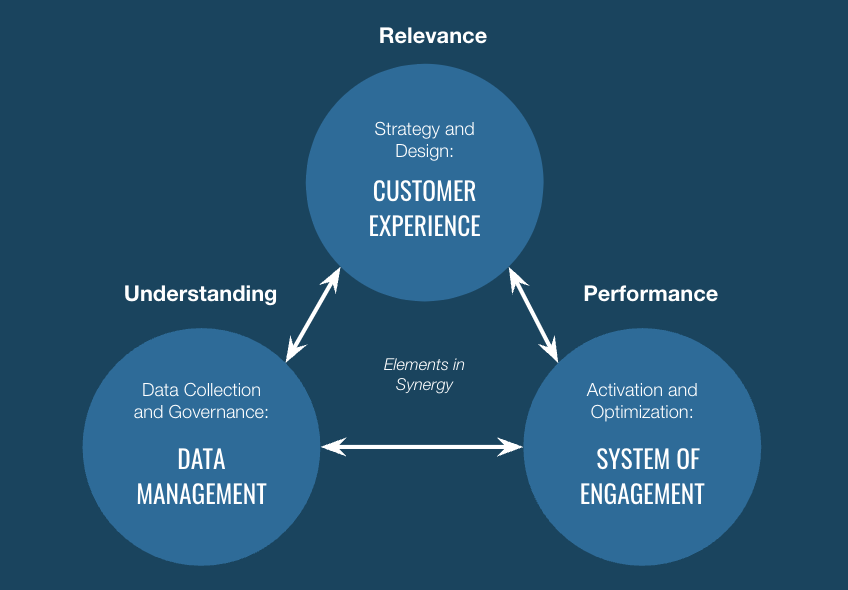Vice-President Data & Customer Experience, Partner
Why is customer satisfaction essential to loyalty?
Vice-President Data & Customer Experience, Partner
The goal of relationship marketing is simple: to increase the value of a company’s customer base and maintain customers’ engagement with the brand for as long as possible by ensuring their satisfaction.
In our opinion, to fulfill their goals, organizations need to focus their efforts in three main areas (summarized in the chart below):
- understanding their customers through data and analytics;
- integrating a high-performing system for engagement that facilitates communicating with target segments on the right channel at the right time; and
- developing a unique customer experience.
It’s this last point that we’ll be discussing in more detail in this article.

Key elements in managing customer experience
A company can’t hope to retain loyalty and keep customers engaged without offering them a pleasant experience every time they interact with the brand.
When based on a good understanding of customers and a detailed analysis of their various points of contact with the brand, customer experience (or CX) is one of relationship marketing’s most powerful tools. It enables companies to design an ideal customer journey that can contribute to promoting the engagement and loyalty of their customers. By participating in the development of a unique experience throughout the customer life cycle (from acquisition to conversion, retention and loyalty), CX management aims to provide value with every brand interaction.
Seems obvious, doesn’t it?
In fact, consistency is hard to achieve.
A Gartner study (CMOs: Time to Be More Customer-centric) revealed that marketers invest a lot of their effort into customer relationships during the purchase phase, but too often forget to ensure customer satisfaction following the sale of their product or service. In addition, the study demonstrated that investments are mainly directed into channels and campaigns, rather than on deepening their understanding of customers and their needs.
In order to refine their understanding of their target public, a company must efficiently manage its relationship marketing program (or launch one, if they haven’t yet) by focusing on three aspects:
- understanding the needs and goals of their customers (at the risk of repeating myself, I should say that data are essential to succeeding at this activity);
- mapping or designing the customer journey (it’s important to understand the phases of each stage of the customer life cycle); and
- the link uniting each initiative with quantifiable and measurable business goals.
Understanding the customer
According to Gartner, 63% of marketers are of the opinion that translating customer understanding into specific initiatives remains a major challenge even today.
A detailed understanding of customers can only be obtained through the analysis of behavioural data; the importance of attitudinal data, which is often collected through surveys, is critical for anyone interested in truly understanding the motivations, needs and expectations of end users. And yet, when looking at the operations of many companies, you will immediately notice that marketing based on hypotheticals (which, by definition, haven’t yet been proven) remains the norm. This doubtlessly explains the failure of many attempts to improve customer experience.
For organizations, understanding key moments in the customer journey is fundamental and essential to being able to offer customers a unique and memorable experience. This means investment in qualitative data (surveys, market studies, competitive analysis, NPS, CSAT) is necessary to finish creating the portrait you started making based on quantitative data. Combining these two types of data occurs through the use of personas.
Mapping the customer journey
Mapping the customer journey is an essential exercise for facilitating great customer experience. It lets you increase your understanding of customers by locating the most important moments in their interaction with the brand, but also by sequencing their interactions. Analyzing their points of contact lets you determine areas that can be improved by reducing friction.
Once equipped with a good customer journey map, a company will be able to easily develop a strategy for improving CX, thereby maximizing the impact of their various initiatives on their business goals.
Designing the customer journey
To optimize the map’s efficiency, you must ensure the map aligns with the phases of the customer life cycle, a sensitive aspect of relationship marketing. This exercise is a major ingredient in designing the customer journey since it will promote your ability to communicate with users at the right time on any channel.
Customer points of contact in the after-sale phase, among other times, are important moments for generating value.
Here are a few examples of deliverables resulting from designing the customer journey:
- a measurement plan focused on points of contact
- tactics centred on points of contact
- crucial information for creating personas
The alignment of personas with business strategy
While data segmentation is an excellent place to start, this exercise must absolutely be accompanied by the creation of personas. These must be based on the various segments identified and should be enriched with elements from the customer journey map, as well as the results of qualitative analyses (surveys, market studies, etc.).
Personas won’t be relevant if they can’t resolve actual customer issues (such as facilitating the use of products and services, adding value to interactions with the brand, inciting engagement, etc.).
Among the more important criteria for creating successful personas is ensuring they are firmly actionable and applicable within the company’s business context. Personas need to be created with care, ensuring they are accurate, coherent and applicable, since such a tool will strongly influence your business, marketing and customer strategies.
Finally, actions intended to reach each persona must respond to issues that have true impact on the company’s performance. Special priority should be placed on channels with the most influence on company revenue and profits.
*
I hope this article has convinced you of the essential importance of customer experience in relationship marketing.
If I’ve been able to pique your curiosity with new information, or if you need a hand integrating strategies to improve customer experience into your relationship marketing program, don’t hesitate to get in touch with us. Our specialists are ready to listen and would be happy to help.













